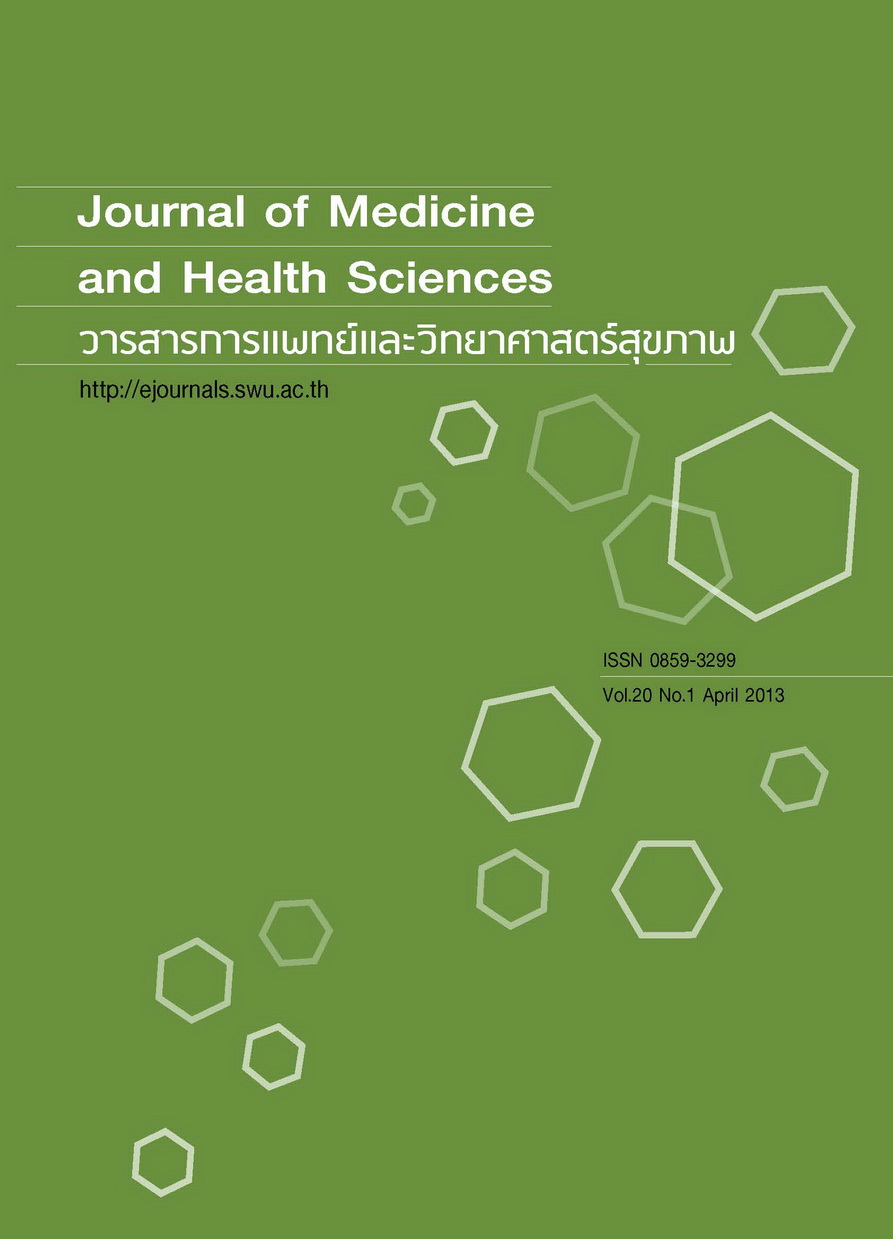Overweight, obesity and sickness absence among the workers in an automotive parts factory
Keywords:
น้ำหนักเกิน, โรคอ้วน, การลาป่วย, Overweight, Obesity, Sickness absenseAbstract
The objective of this study was to identify the difference of sickness absence between overweight or obese workers and normal weight workers in an automotive parts foctory. The incidence and length of sickness absence were studied as well. The samples were 556 workers who work in an automotive parts factory in the Lad Krabang industrial estate, Bangkok. The data were collected during 1 June to 30 November 2012 by using questionnaire and sickness absence record form. Percentage and mean were used to report, and chi-square and ANOVA were used to analyze data in this study. The results found that the overall incidence of sickness absence in 6 months was 28.6% while in normal weight, overweight and obese workers were 22.8, 32.1 and 38.3, respectively. Upon analysis of the difference of sickness absence incidence between groups, there is the statistically significant difference with p-value <0.01. It also shows a trend between incidence rate and BMI (p<0.01). For the average length of sickness absence in 6 monts, the overall wass 10.9 days while in normal weight, overweight and obese workers it was 0.85, 1.13 and 1.57 days, respectively. The length of sickness absence was also different between group with p-value=0.02. However, there is only significance between the obese and normal weight groups when tested by Bonferroni. In conclusion, not only is the health of overweight and obese workers affected, but also their work.
ภาวะน้ำหนักเกินและโรคอ้วน กับการลาป่วยของคนงานโรงงาน ผลิตชิ้นส่วนรถยนต์แห่งหนึ่ง
การศึกษานี้มีวัตถุประสงค์เพื่อศึกษาความแตกต่างของการลาป่วยในกลุ่มคนงานที่มีภาวะน้ำหนักเกินและโรคอ้วน กับกลุ่มคนงานที่มีภาวะน้ำหนักตัวปกติรวมถึงศึกษาอุบัติการณ์ของการลาป่วยและจำนวนวันในการลาป่วยของคนงาน โรงงานผลิตชิ้นส่วนรถยนต์แห่งหนึ่งในนิคมอุตสาหกรรมลาดกระบัง กรุงเทพ จำนวน 556 คน ตั้งแต่วันที่ 1 มิถุนายน พ.ศ. 2555 ถึงวันที่ 30 พฤศจิกายน พ.ศ. 2555 โดยใช้แบบสอบถามและแบบฟอร์มบันทึกข้อมูลการลาป่วย วิเคราะห์ข้อมูล โดยใช้ร้อยละ ค่าเฉลี่ย การทดสอบ Chi-Square และการทดสอบ ANOVA ผลการศึกษาพบว่า ในระยะเวลา 6 เดือน มี อุบัติการณ์ของการลาป่วยของกลุ่มตัวอย่างทั้งหมดร้อยละ 28.6 โดยกลุ่มคนงานที่มีน้ำหนักตัวอยู่ในเกณฑ์ปกติมีอุบัติการณ์ ของการลาป่วยร้อยละ 22.8 ส่วนกลุ่มคนงานที่มีภาวะน้ำหนักเกินและโรคอ้วนมีอุบัติการณ์ของการลาป่วยร้อยละ 32.1 และ 38.3 ตามลำดับ เมื่อทำการทดสอบทางสถิติพบว่า อุบัติการณ์ของการลาป่วยในแต่ละกลุ่มมีความแตกต่างกันอย่างมีนัย สำคัญทางสถิติ(p-value <0.01) นอกจากนี้ยังพบแนวโน้มความสัมพันธ์ระหว่างอุบัติการณ์กับดัชนีมวลกาย (p<0.01) เมื่อ คำนวณหาจำนวนวันในการลาป่วยโดยเฉลี่ยของกลุ่มตัวอย่างทั้งหมด ในระยะเวลา 6 เดือน พบว่า มีจำนวนวันเฉลี่ยในการ ลาป่วย 1.09 วัน โดยกลุ่มคนงานที่มีน้ำหนักตัวอยู่ในเกณฑ์ปกติมีจำนวนวันเฉลี่ยในการลาป่วย 0.85 วัน ส่วนกลุ่มคนงานที่ มีภาวะน้ำหนักเกินและโรคอ้วนมีจำนวนวันเฉลี่ยในการลาป่วย 1.13 และ 1.57 วัน ตามลำดับ เมื่อทำการทดสอบทางสถิติ พบว่าจำนวนวันเฉลี่ยของการลาป่วยในแต่ละกลุ่มมีความแตกต่างกันอย่างมีนัยสำคัญทางสถิติ(p-value = 0.02) อย่างไร ก็ตาม เมื่อทดสอบความแตกต่างระหว่างกลุ่มด้วยวิธีBonferroni พบว่าเฉพาะกลุ่มคนงานที่เป็นโรคอ้วนแตกต่างกัน กลุ่มคนงานที่มีภาวะน้ำหนักตัวปกติอย่างมีนัยสำคัญทางสถิติโดยสรุปนอกจากภาวะน้ำหนักเกินและโรคอ้วนจะส่งผล กระทบต่อสุขภาพคนงานแล้ว ยังมีผลกระทบต่องานด้วย



